 Part of my thinking when I agreed to co-teach a permaculture design course at the remote Maya Mountain Research Farm in Belize was that this was an adventure I could still do. My days of trekking the Himalayas or backpacking the Inca trail are probably over, unless I get a new pair of knees, but teaching in a tropical paradise an hour upriver from the nearest town sounded like something exciting but still within my capacities.
Part of my thinking when I agreed to co-teach a permaculture design course at the remote Maya Mountain Research Farm in Belize was that this was an adventure I could still do. My days of trekking the Himalayas or backpacking the Inca trail are probably over, unless I get a new pair of knees, but teaching in a tropical paradise an hour upriver from the nearest town sounded like something exciting but still within my capacities.
But as I stare down at the narrow little dugout canoe, loaded with baggage, including all the manuals for the course and my computer, I begin to wonder if I’ve miscalculated. Yes, I could sit in the boat and be poled a clear, bottle-green river surrounded by lush jungle. But first I have to get into the boat—not so easy when your knees no longer bend gracefully and the narrow, heavily-laden canoe rocks back and forth with all that electronic equipment balanced precariously.
“How about hiking up the trail?” I suggest.
There’s a group of us onshore, myself and a couple of the international students who have come for the course, and a crowd of the Mayans. There are more of us than can fit in the boat, especially with all of our stuff.
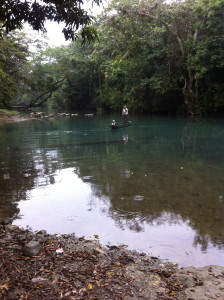 Sinovia, a tiny crone with a big smile who lives just upriver from the Research Farm, is also onshore waiting for her husband to come back with their dory.
Sinovia, a tiny crone with a big smile who lives just upriver from the Research Farm, is also onshore waiting for her husband to come back with their dory.
A long discussion ensues between Sinovia and Jorge, who is waiting to pole the boat. The trail is too muddy, they suggest. Too steep. I can tell by the way they look at me that they think I’m not capable of walking it. I assure them that I walk up and down steep hills all the time, which I do. Not fast, and the knees might hurt, but I make it. But in the end they decide that Jorge will come back for another trip and try to bring a wider dory.
The rain falls, and Jorge poles Maggie and Emma upriver with the baggage while the rest of us wait. Sinovia and I retreat to a thatched palapa along with Paulina, one of the young Mayan women who are coming to the course. Paulina wears a blue dress with long skirt and puffed sleeves in the Mennonite style—the Mennonites have established many missions in Belize and have many converts. She’s 22, and tells us how much she wanted to go to High School and get an education. But her father would not support her to do that, so instead she took every course offered in her village, where Peace Corps volunteers taught nutrition and other subjects and attempted to organize a youth group. The youth group never quite took off, so she joined the local Women’s Group where she was immediately elected the leader. She’s delightful and I’m thrilled to think we can help her learn skills and tools that she can bring back to her group and her village. The time passes quickly until Jorge returns.
This time he brings a slightly wider, though more leaky, dugout. Without the threat of tipping our baggage into the water, I’m able to lower myself in and settle back for an idyllic journey upriver.
We disembark at a spot on the bank where a few large stones provide a landing. I thank Jorge and make my way up the steep trail through a lush rainforest. I pick out banana trees, coconut palms, papaya, and later what I learn is that all of what appears to be wild jungle has actually been planted by Christopher Nesbitt, who started and runs Maya Mountain Research Farm. This is a food forest, where every plant provides something useful either for humans or for the support of the system.
Atop the trail, I find the center of the farm, a beautiful timber and stone house built by Chris with a wide, roofed patio and a big, outdoor kitchen. Here we will eat, socialize, and teach our course.
I’m eager for this adventure, also, because I hope to learn from my fellow teachers and our students. Chris, a big, gruff bear of a man with a shaggy beard and a warm heart, has been at Maya Mountain for more than twenty years and turned it from a played-out citrus grove on an eroding hillside into a model of tropical permaculture. My knowledge of tropical systems is not my strong point in permaculture, and I am excited to see what he has done and to learn from him.
Albert Bates is also teaching with us. Albert has lived for decades on The Farm in Tennessee, one of the largest and longest-lasting of the hippie communes now transformed into an ecovillage. I met him first at the International Permaculture Convergence in Jordan where he enthralled me with his presentation on biochar and its potential for sequestering carbon, building fertile soil, and mitigating climate change. Now he works on a global scale to help communities and businesses transform their practices to become ‘carbon-cool’.
And our fourth teacher is Marisha Auerbach, whom I know from many gatherings. She has done some brilliant home-scale designs, and she has a bright smile and a warmth that really helps her connect with our students, including the shy young women!
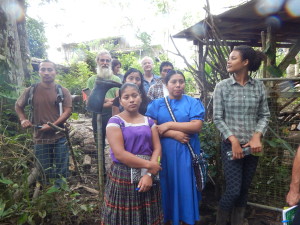 Our students are a real cross-section of Belizean society. There are young Mayan sisters from a village high in the mountains, and also university graduates who now work in organizations like the Cacao Growers Association or local conservation reserves. We have two Garifuna students—the Garifuna people come from the coasts and are descended from escaped African slaves and Arawak Indians, with maybe a bit of pirate along the way. Miss Perlin takes no nonsense from anyone, commandeers one of the hammocks and loves plants. Everywhere we go, she’s collecting seeds and cuttings.
Our students are a real cross-section of Belizean society. There are young Mayan sisters from a village high in the mountains, and also university graduates who now work in organizations like the Cacao Growers Association or local conservation reserves. We have two Garifuna students—the Garifuna people come from the coasts and are descended from escaped African slaves and Arawak Indians, with maybe a bit of pirate along the way. Miss Perlin takes no nonsense from anyone, commandeers one of the hammocks and loves plants. Everywhere we go, she’s collecting seeds and cuttings.
Dr. Arzu is a naturopath, a healer, and a mover and shaker, married to the former Commissioner of Archaeology who is the mayor of their town. The Garifuna people specialized in education, provide most of the teachers in Belize, and have a very high number of Ph.Ds among them. Dr. Arzy studied for many years in New York, and I love her beautiful Brooklyn accent! She and Miss Perlin collude in the plant collecting! I only wish I could join them and grow some of these tropical species back home. I get a strong sense that this course will have a major impact in Belize. Dr. Arzu’s community has just acquired a huge tract of land. Felipe will spread permaculture sensibility among the cacao growers he works with. And I’m betting on Paulina to grown into leadership beyond her village!
And the influence will spread beyond, through our international students who come from the US, England, Greece, and Trinidad, where John Stollmeyer runs the Caribbean Permaculture Consultants and is an incredible artist and performer.
We get a full tour of Chris’ systems, and a chance to dig some swales while trying to avoid the leaf-cutter ants! We make biochar, work in the garden, and have lots of interesting discussion. On breaks, there’s the hammocks…and the river…
One day we have a field trip to Mr. Saul Garcia’s farm and preserve. We float downriver in our bathing suits to get there. He’s a self-taught villager who was given a piece of steep, undesirable played-out land and on it has planted a stellar tropical polyculture. It’s a perfect model of the permaculture principle of creating self-sustaining, mutually supportive polycultures. We get to tour his shade-grown cacao trees, and drink coconut water from nuts straight off the tree. The store-bought stuff just can’t compare!
After lunch we hike over the hill to the Eladio Pop food forest and cacao groves, where the Pop family raises and processes regeneratively-grown cacao! Did you know there were many different kinds of cacao pods? And that it is possible to have chocolate without guilt—not only that, to raise cacao in ways that actually regenerate the soil and provide habitat for birds and animals? Again, it’s those perennial polycultures!
Our class works hard on their design projects in the second week of the course, and we are so proud of the work they all do. Even the shyest of the young women stands up and presents her part of the project!
Our last day is an extended field trip that feels like a vacation. We begin with a tour of Burton’s Farm, a great example of organic vegetable growing with food forests surrounding. It’s what Mr. Burton calls ‘agree-culture’: we agree with nature, agree with each other, agree with the plants and the web of life, and produce food, fertility and a good quality of life.
We get a quick tour of the Mayan ruins at Lubantum, and end with a swim in the sparkling, azure Blue Creek. What a beautiful end to an amazing adventure, all the more meaningful because I have the privilege of giving back a little bit to this amazing country!
Thanks to Christopher Nesbitt for inviting me, and for all of his work to build the Maya Mountain Research Farm. And thanks to the LUSH Charity Pot Program for generously supporting scholarships for our local students. Their support made it possible to train such a broad section of Belizean society, and the ripple effect will be huge!

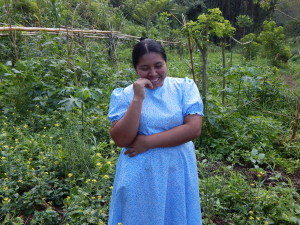
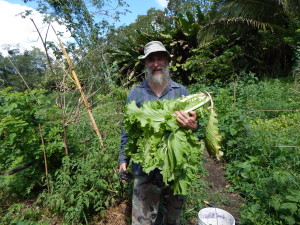
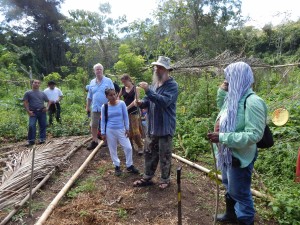
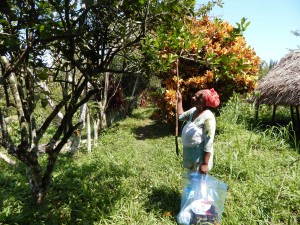





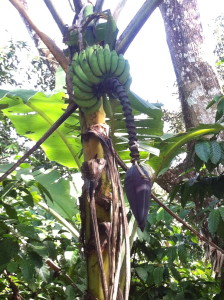
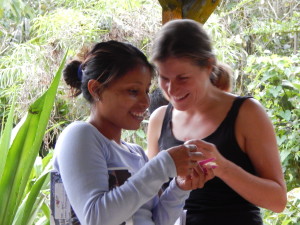

Starhawk,
It was an honor and a privilege to work with you. Thank you, so much, for taking the time to be here. I loved having you here, and hope to have you here again, some day.
Warm wishes,
Christopher
Thanks, Christopher. It was an inspiration to be at your beautiful center, and to meet so many wonderful people from all walks of life in Belize. I will be back someday!
[…] Vir fotografije: https://starhawk.org/maya-mountain-research-farm-my-permaculture-adventure-in-belize/ […]
Hey Chris
This is Penny from Aussies Living Simply. I was surfing the web looking for some stuff as I am redesigning some gardens at a school and teaching the kids basic permaculture when I came across your stuff. I haven’t spoken to you for so long. How are you? Would love to keep up with you.
Cheers
Penny
Hi Penny,
I just found this.
I am fine. Busy.
How are you?
C
Hey Starhawk-
I had the pleasure of meeting and hearing you when you came to speak in a classroom at Vanderbilt in Nashville, a couple years back. My friend Beth Conklin, who was a professor there, invited me. I’m a songwriter and played some music for the attendees before your arrival and after your wonderful session, and bought your book, “The Fifth Sacred Thing”. Anyway, THANK YOU for this great blog post on Maya Mountain Research Farm. Although it is several years old, I found it wonderfully informative and engaging! I’ll be going to Placencia, Belize once again with my husband in about three weeks (Feb. 4th-18th, 2019). Wanted to visit MMRF the first time, two years back, but was unable. Hoping to do so this time. I have studied permaculture and obtained my PDC in 2012. I also know Albert Bates and have visited the Ecovillage at The Farm in Summertown numerous times in the past. So happy to come across this, so thanks again!